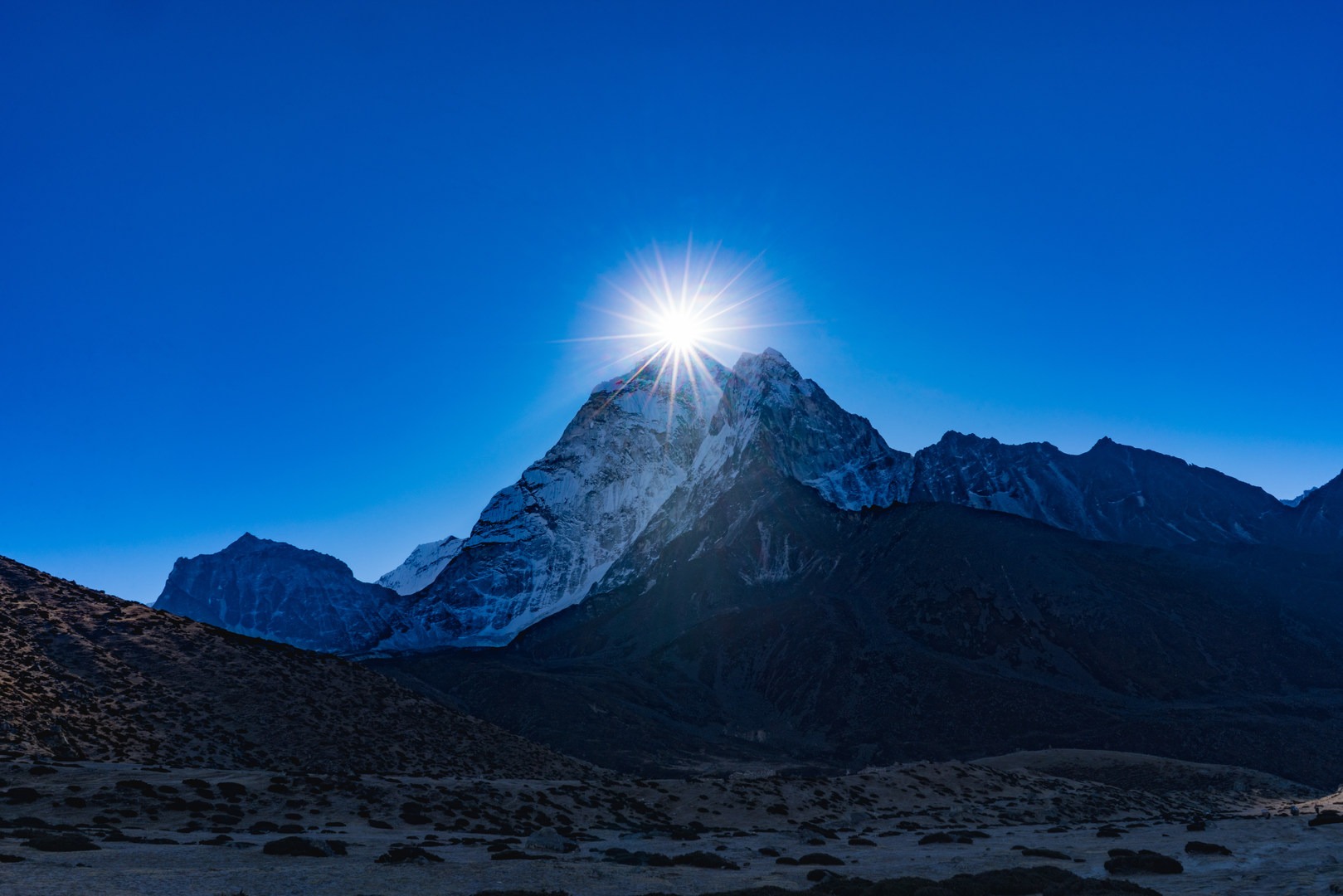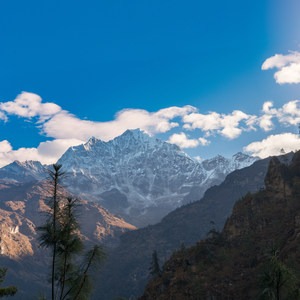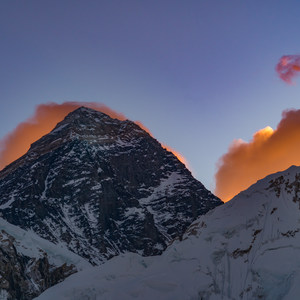You are here
The upper portion of the Khumbu Valley marks a larger portion of the trek to Everest Base Camp, tackling much more elevation gain than the section below Namche Bazaar. Above the colorful streets of the bustling marketplace, the trail begins contouring along some of the tallest mountains in the world, high above the valley floor below. Views of stunning and majestic peaks are a regular occurrence around every bend. Religious sites, such as the Tengboche and Dingboche monestaries, offer a unique view into Buddhist culture in the region. The food becomes more basic higher up as well, with otherwise generally reliable services such as Wi-Fi and hot showers becoming difficult to come by. Sharing the trail with numerous other trekkers and guide groups can cause the accomodations to book up fast, especially during the high seasons. Small villages become even smaller as trekkers ascend the terminus of the glacial moraine leading up to Everest Base Camp. Here the landscape is transformed; towering giants flank a rocky desert ripped by cold winds and slow-moving ice.
Everest Base Camp, although out of view from the peak itself, is still quite picturesque with prayer flags and a signpost marking the makeshift camp situated on glassy blue glacier ice. Just above sits the dangerous Khumbu Icefall, arguably one of the most trecherous challenges faced by climbers seeking the summit. For the best views of Mount Everest, guides suggest making the journey up to the summit of Kalapatthar (5,545 meters) for a spectacular viewing of sunrise bathing the tallest mountain in the world. This opportunity, although painfully steep, exhausting, and cold when done in the darkness, offers a once-in-a-lifetime view and is much more climactic than EBC itself. As difficult as it can be to wake up before dawn only to emerge from a warm sleeping bag and trudge off into the freezing night with a pounding head and burning lungs, do not forego this incredible experience! If properly acclimated, trekkers will feel strong and fast on the way back down, making their way back to Lukla in only three days or so.
Day 4: Namche Bazaar to Tengboche Monestary (3,800 meters)
Get an early start on the trek from Namche and make your way along the contoured ridges for another five to six hours. Not long after leaving you'll have your first views of Ama Dablam and the upper Khumbu region along with many other high peaks. Be sure to take the time to enjoy mid-morning tea in the warm sunlight outside a guesthouse along the trail. Soon you will begin a steep descent to the Dudh Koshi River before crossing another suspension bridge. Take some time to rest before ascending the steep trail back up the other side. Here the switchbacks snake through rhododendron, pine and oak forests in a seemingly endless track to the top of the ridge. In terms of challenge, this notorious hill is a close second to the switchbacks leading up to Namche Bazaar, so take it slow! The first view of the Tengboche monestary will be a welcoming sight. See if you can arrange a unique look into the monestary itself, where Buddhist monks are often seen chanting. Staying in Tengboche is not as common as heading a few minutes down the trail (off the ridge), where the lodging is much warmer and more protected from strong winds. If you do stay in the monestary, be aware that temperatures can fall well below freezing; make sure to keep all of your electronics and drinking water in your sleeping bag while you sleep, and don't be afraid to ask for an extra blanket!
Day 5: Tengboche to Dingboche (4,360 meters)
The morning after a cold night can be difficult, and it doesn't help that much of the beginning of this six- to seven-hour route down from Tengboche and then up to Dingboche sits in the frost shade, which makes for some numb fingers and toes. The journey continues through alpine forests to a large village of upper Pangboche and further through the village of Shomare, which is a good stopping point for lunch. From here you can see the soaring mountains of Taboche, Thamserku, Ama Dablam, Nuptse, Cholatse and Lhotse along with others. Continue through increasingly high ridges to the outskirts of Dingboche, where a short, steep ascent up the valley floor marks the end of another long day.
Day 6: Acclimatization and rest day in Dingboche (4,360 meters)
Dingboche is a good place for a rest day that will allow your body to adjust to all of the altitude gain in this portion of the trek. From Dingboche you can ascend a few hundred meters to the nearby stupas and prayer flags, where you can enjoy views of Island Peak, Nuptse, Lhotse, and the upper valleys for tomorrow's trek. Return to Dingboche for some rest, food, and time around the stove.
Day 7: Dingboche to Lobuche (4,940 meters)
The five- to six-hour climb from Dingboche passes Duglha and the glacial runoff from high above. Look for Yak herders and Chola Lake as you make your way up the valley. After crossing the icy flowing river below Duglha you will begin the steep hike up Duglha Pass, the terminal moraine of the Khumbu glacier. This steep section of the trail would otherwise be a breeze if not for the intense altitude. Go slow! At the top, take time to appreciate the collection of stones with prayer flags used to commemorate American mountaineers Scott Fischer, Rob Hall, and others who lost their lives on Mount Everest. Beautiful views of Khumbutse, Mount Lingtse, Mount Pumori and Mount Mahalangur can be viewed as the trail crosses the Khumbu Glacier and arrives at last in Lobuche, nestled next to Lobuche Peak and a lazy glacial river.
Day 8: Lobuche to Everest Base Camp (5,364 meters) and back to Gorakshep (5,150 meters)
This is one of the longest days of the trek, and you'll have to traverse the boulder fields that make up the lower Khumbu glacier. This is tedious and slow at times, and crossing the vast boulder fields can be surprisingly draining, especially at this altitude. Mount Nuptse, Mount Lhotse, and Mount Pumori can be viewed along this section of the trek, though Mount Everest can be elusive, which feels unusual given its proximity. The numerous ups and downs during this section are difficult; your burning lungs and pounding hearts will noticeably affect your hiking abilities. Gorakshep, the last village before base camp, is a welcoming sight situated among the rocky terrain. It is a good rest point for lunch before continuing alongside the glacier to reach EBC in another couple of hours. After a quick lunch at Gorakshep, drop the heaviest items in your pack and begin the steady traverse along the rocky and sometimes icy flanks of the Khumbu Glacier. The peak of Everest slowly comes back into view, and passing trekkers will continuously tell you that you're "so close" to EBC. One final descent onto the glacier itself leads to the sign marking the center of base camp, which sits at roughly 5,364 meters. The intense wind funneling up the valley can be chilling, so quickly snap a few pictures and take in the amazing views up into the Khumbu Icefall before you begin your return journey back to Gorakshep for the evening. On a clear night the moon reflects brightly off of the snowy peaks high above as the stars emerge in multitudes. You'll want to head to your sleeping bag early to prepare for an early start in the morning.
Day 9: Gorakshep to Kalapatthar (5,545 meters) and down to Pheriche (4,280 meters)
This is it, the climax of the trip. Start in the dark so that you can witness Mount Everest bathed in fiery colors at sunrise from the nearby peak of Kalapatthar. Ascended slowly up the rocky path to the summit of Kalapatthar by headlamp, and be prepared for windy and cold conditions that can freeze your drinking water. After a grueling climb in the numbing cold, amazing views of the summit of Everest will reward you. This is, without a doubt, the best view of Everest and its surrounding peaks, although many climbers forego ascending this high due to fatigue or sickness. After a quick descent back to Gorakshep for breakfast, pack your things and began the long six- to seven-hour journey down the valley, past Lobuche and Duglha Pass, and along the meandering streams and prairie-like expanse above Pheriche. Going downhill is much faster, but it is also very hard on the joints. Rest your knees after a relentless descent and treat yourself for sucessfully making it to and from the highest point on the trek.
Day 10: Pheriche to Namche Bazaar (3,440 meters)
The descent continues along the same route used to ascend, passing through Shomare and Pangboche once more. At Pangboche you can explore the oldest monastery in the region, which has the legendary head and bones of a yeti. Pay a donation to the monks to see it and for a closer look inside the monastery. From Pangboche you'll cross a few more bridges above the Dudh Koshi River and make your way through pine forests, and up and down the steep ridge of Tengboche, where you likely struggled just days before. While your legs and lungs will feel stronger with most of the altitude behind you, the steep sections back up to the contours before Namche Bazaar are still tiring after covering so much mileage. Before reaching Namche, the views of Ama Dablam and other giant mountains will begin to fade away and disappear as you round the corner into town.
Day 11: Namche to Phakding and then to Lukla (2,800 meters)
The last day of actual trekking continues with the steep downward trail from Namche Bazaar. It is much more enjoyable to be heading down the endless switchbacks this time! Good trekking poles and a slow, controlled descent are key to avoid knee injuries. Upon reaching the suspension bridge over Dudh Koshi, nearly 200 meters above the rapids below, you'll pass through the open plain and rhododendron forest while enjoying the final steps through quiet mountain villages. The last few miles to Lukla come at the end of the six- to seven-hour hike and a final tedious ascent out of Phakding. Treat yourself with a shower, some last-minute shopping, and a well-deserved round of beers.
Day 12: Flight back to Kathmandu (1,400 meters)
Pack your bags for an early morning flight back to Kathmandu. Yet again you'll be able to experience the thrilling takeoff from the cliff-side runway. Upon reaching Kathmandu, taxi back to Thamel to enjoy a massage and a nice meal in the touristy district as you celebrate a successfully completion of the EBC trek!
For additional coverage of the trekking to Everest Base Camp, check out the following articles:
Logistics + Planning
Current Weather: Powered by Dark Sky
































Comments
Sign In and share them.